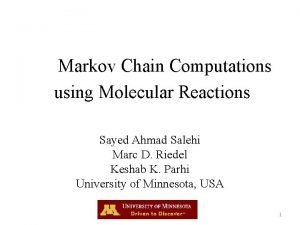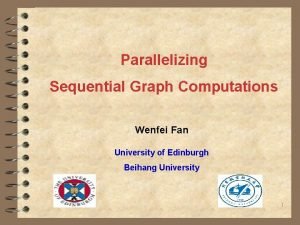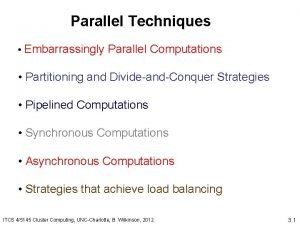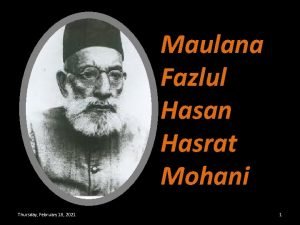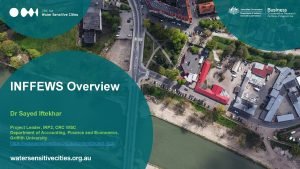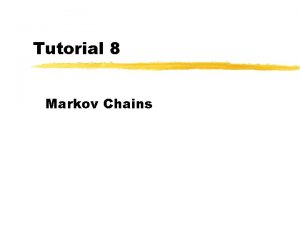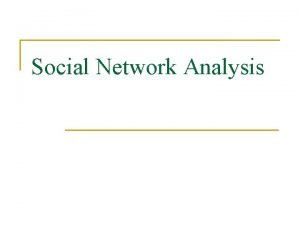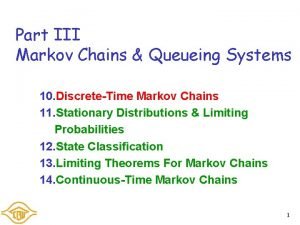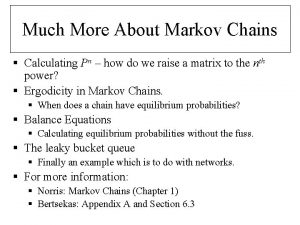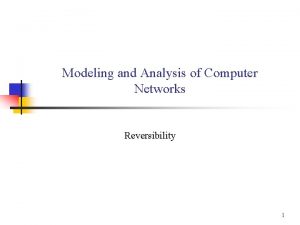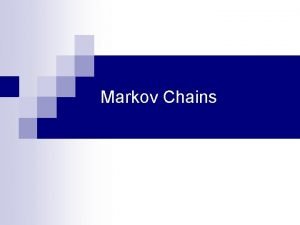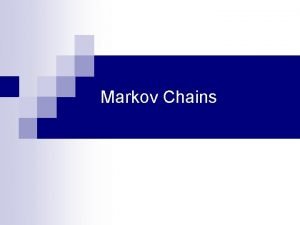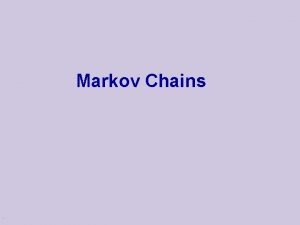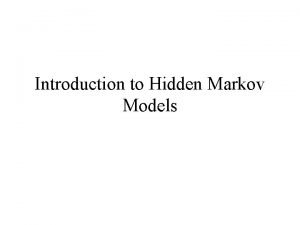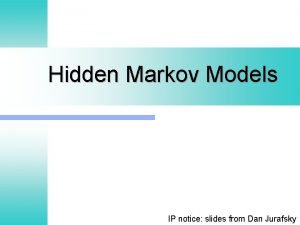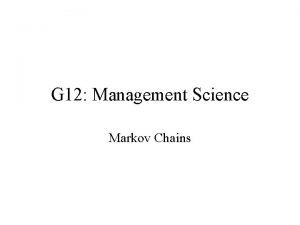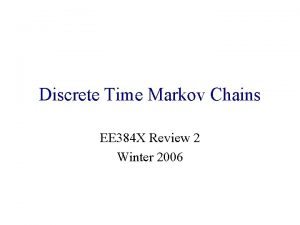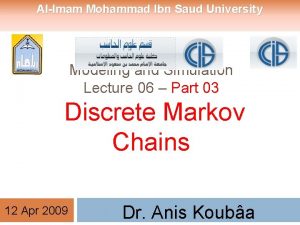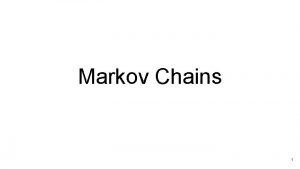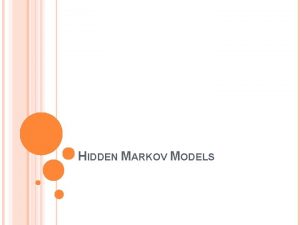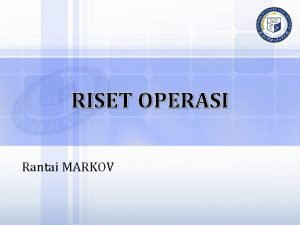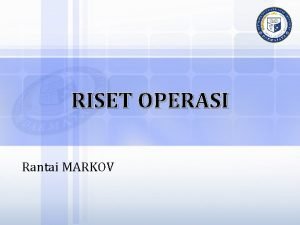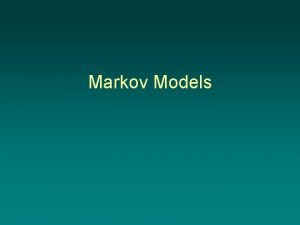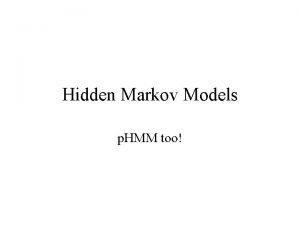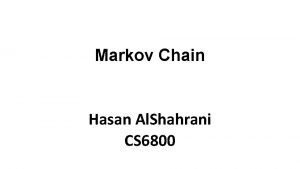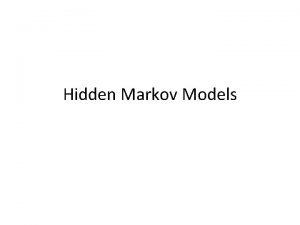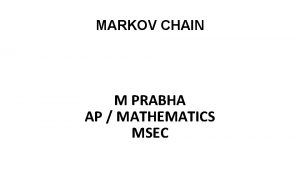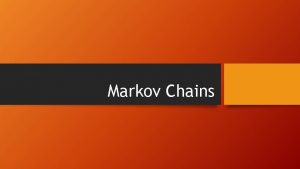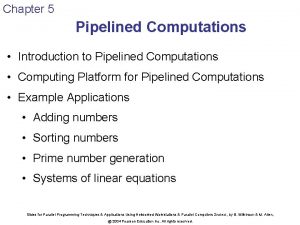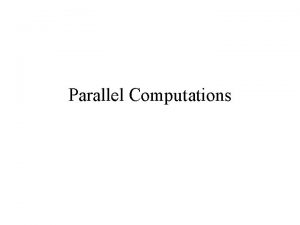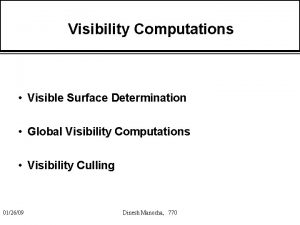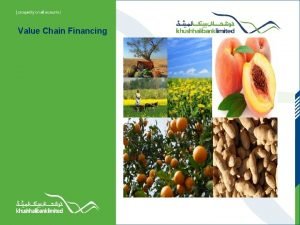Markov Chain Computations using Molecular Reactions Sayed Ahmad























- Slides: 23

Markov Chain Computations using Molecular Reactions Sayed Ahmad Salehi Marc D. Riedel Keshab K. Parhi University of Minnesota, USA 1

Outline • Introduction • Modeling of Molecular Systems – Mass-action Law – Stochastic Kinetics • Markov Chain (Random Process) – Gambler’s Ruin Problem – Modeling by Molecular Reactions • Analysis • Simulation Results • Summary 2

Introduction • DNA Computation • Combinatorial Problems • Hamiltonian(Adleman, 94), Maximal Clique(Ouyang, 97) • Deterministic Functions • Addition (Guarnieri, et al. , 96), Semilinear Functions (Chen, et al. , 2013) • Logical Functions • Seesaw Gates (Qian, et. al. , 2011), … • Signal Processing • Discrete Time Signal Processing (Jiang, et. al. , 2013) • … 3

Computational Modules Constant Multiplier

Computational Modules Adder

DSP with Reactions 10, 2, 12, 8, 4, 8, 10, 2, … … 5, 6, 7, 10, 6, 6, 9, 6, … Reactions Input molecular type … Output molecular type How do we find such reactions?

Molecular Modeling • • Stochastic chemical kinetics: 7

Molecular Modeling • Stochastic chemical kinetics: Each reaction can be fired randomly P(R 1) and P(R 2) change after each event. 8

Markov Chain (1 st order) Markov Property: Past and future values of the process are conditionally independent given the present value. 9

Gambler’s Ruin Problem Gambler starts with i dollars and plays game of chance in each step, either increasing his money by $1 or decreasing by $1. He stops when money is gone or when he has N dollars. What’s the probability of “ruin”? 10

Modeling by Molecular Reactions Initialization State transfer reactions:

Analysis (Mass-action model) Mass-action: 12

Analysis (Stochastic model) Stochastic Kinetic: 13

Simulation Results (Mass-action model) • ODE simulation S --A B E Theory: ruin probability= 0. 8861 , win probability= 0. 1139 15

Simulation Results (Stochastic model) • Monte Carlo simulation iteration=106 Simulation: Ruin probability= 0. 8861, Win probability= 0. 1139 E S Theoretical and simulation results in both mass-action and stochastic models match well. 16

DNA Strand Displacement X 1 X 2 + X 3 D. Soloveichik et al: “DNA as a Universal Substrate for Chemical Kinetics. ” PNAS, Mar 2010

DNA Strand Displacement X 1 + X 2 X 3 D. Soloveichik et al: “DNA as a Universal Substrate for Chemical Kinetics. ” PNAS, Mar 2010

Modeling by DNA strands • Template for each reaction 19

DNA Simulation Results S A B E 20

DNA Simulation Results For N=9, concentration for state H=100 A B C D F G H Ruin Win 21

DNA Simulation Results For N=9, concentration for state C=100 RUIN A B C D F G H WIN 22

Summary • Implementing Markov chain with molecular reactions • Applicable for analyzing and synthesizing artificial models to emulate stochastic behavior of natural biological systems 23

Future Work • Implementation of more complex natural biochemical systems using their Markove chain model. 24
 Sayed ahmad salehi
Sayed ahmad salehi Sayed hadi hashemi
Sayed hadi hashemi Incrementalizing graph algorithms
Incrementalizing graph algorithms Embarrassingly parallel
Embarrassingly parallel El sayed el ayouty and company
El sayed el ayouty and company Photo
Photo Sayed iftekhar
Sayed iftekhar Grazing food chain diagram
Grazing food chain diagram Markov chain absorbing state
Markov chain absorbing state Absorbing state
Absorbing state Hidden markov chain
Hidden markov chain Aperiodic markov chain
Aperiodic markov chain Embedded markov chain
Embedded markov chain Markov chain nlp
Markov chain nlp Aperiodic markov chain
Aperiodic markov chain Embedded markov chain
Embedded markov chain Homogeneous markov chain
Homogeneous markov chain Aperiodic markov chain
Aperiodic markov chain Aperiodic markov chain
Aperiodic markov chain Hidden markov chain
Hidden markov chain Hidden markov chain
Hidden markov chain Aperiodic markov chain
Aperiodic markov chain Aperiodic markov chain
Aperiodic markov chain Transient markov chain
Transient markov chain
